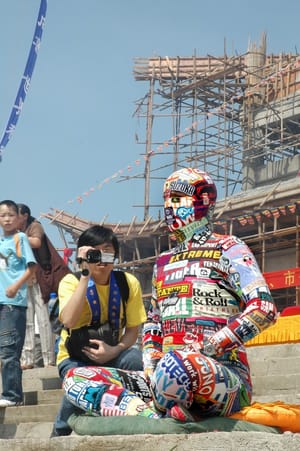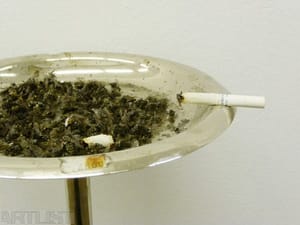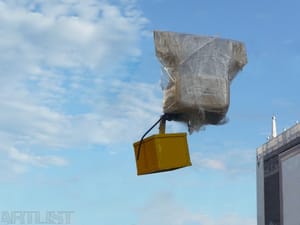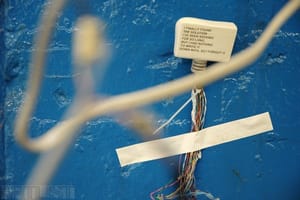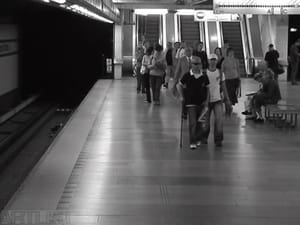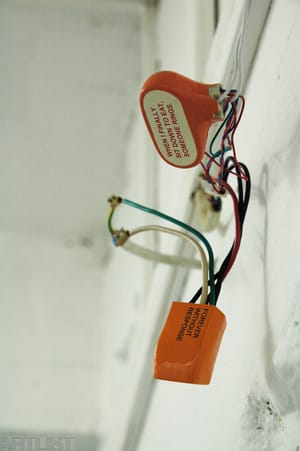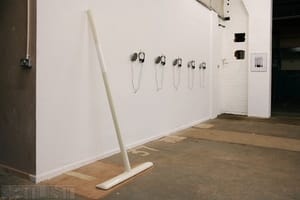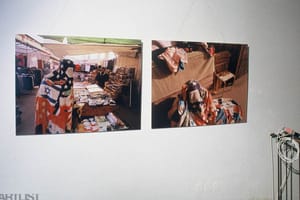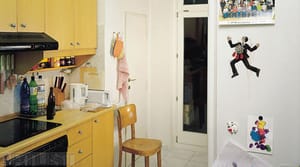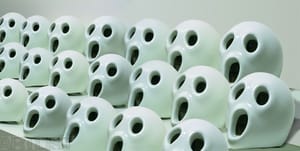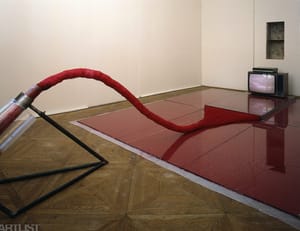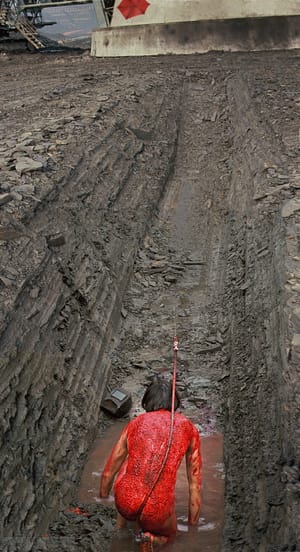- First Name
- Jiří
- Surname
- Černický
- Born
- 1966
- Birth place
- Ústí nad Labem
- Place of work
- Praha
- Website
- https://cernicky.com
- i-datum
- ↳ Find in the VVP AVU database
- CSU Library
- ↳ Find in the catalogue
About artist
Jiří Černický’s work is full of expressive transformations, extreme gestures and also particular humour. Each work by this artist hides a strong story both in the content as well as at the level of seeking adequate expressive resources. Should we wish, nonetheless, to formulate a certain common denominator, then it is essential to mention first and foremost his incessant ability to express an almost childlike wonder and, at the same time, a willingness for open communication, often exaggerated to the point of conflict. Indeed, it is these two components expressing strategy that allow Černický, as if part of perfunctory surfing trip, to expose the dominant waves on the surface of contemporary society.
A certain ambivalence of creative principles otherwise appeared in Jiří Černický’s first fundamental work, Slzy pro Etiopii / Tears for Ethiopia (1993-94). At that time the artist collected from rubbish containers located at the Emil Filla Gallery in Ústí nad Labem the tears of local residents, who after a month of toilsome pilgrimage handed over to the abbot of the monastery in the Ethiopian town of Lalibela. A limited pathos and creative aloofness crossed paths with personal engagement and the artist’s intense physical participation in this project.
Jiří Černický used a similarly ambiguous approach in one of his own formally most-dynamic works, i.e. in the multimedia installation, SONY Garden, dating from 2002. As part of this work the artist engaged in a communication process with representatives of multinational companies and obtained their material support. He later primitively and doggedly destroyed this sponsorship in the form of dozens of various hi-tech electronic devices (monitors, VCRs, printers) and from the materials obtained he constructed a sort of minimalist Zen garden. The global character of the Japanese economy was thus confronted with the traditions of local society and its culture. The impersonal and perfect aesthetic of industrial mass production was transformed into the shape of a post-modern visual haiku.
This relativising approach is not however typical only for Černický’s spectacular and conceptually-limited installations. Rather it appears in his seemingly light-weight and aestheticising painted projects. For example, we can recall without a doubt the bravado-like image series, Bin Ladinova lampa / Bin Laden’s Lamp dating from 1999. In this work the artist combines the principles of colour and shape ornamentalism with specific social themes. The shining and almost hallucinogenic surfaces of these images are complemented by an array of figurative details symbolising the differences in mutual relations between Euro-American and Arab society and culture. The naive and idealised images carried with us from childhood on the almost fairy-tale-like Islamic world of the Middle East are purposely shot down through kitschy pseudo-portraits of warriors from various religious terrorist groups and movements.
- Author of the annotation
- Michal Koleček
CV
Studies :
1993–97 Academy of Fine Arts in Prague
1990–93 Academy of Applied Arts in Prague.
1987–90 Pedagogical Faculty in Ústí nad Labem
1983–87 School of Applied Arts in Jablonec nad Nisou
Awards:
2007 48th October Salon Award, Beograd, Serbia
1998 The Jindřich Chalupecký Award, Prague
1996 The Soros Award, Prague
Exhibitions
- Solo exhibitions
-
2016
WildDreams (Divoké sny), Rudolfinum Gallery, Prague
2015
Real Minimalism (Reálný minimalismus), Josef Sudek Gallery, Prague
Steel Head (Ocelová hlava), Plató Gallery, Ostrava
Dolby Painting – Conquest of Dante’s Hell by Thor Heyerdahl (Dolby malba – dobytí Dantova pekla Thorem Heyerdalem), Adam Gallery, Brno, Czech Republic
2014
Dolby Painting (Dolby malba), Dvorak Sec Contemporary Gallery, Prague
2010
Kefir Path (Kefírová dráha), Woxart Gallery, Prague
The Gagarin Thing (Gagarinova věc), Václav Špála Gallery, Prague
Minimally Intensive (Minimálně intenzivnější), Town Gallery, Blansko
ABS, Muzeum Jed(y)nygo obiektu Toruń, Poland
2009
Věci, kterých mi není líto, Muzeu V. Löfflera Košice, Slovensko
IFO archiv, atelier J. Sudka, Praha
2008
ABS video, SPACE Gallery, Cleveland, USA
Well, one never does the most important things anyway…,
Emil Filla Gallery, Ústi nad Labem
2007
ABS video, Futura Gallery, Prague
You, Artsdepot Gallery, London, UK (s Terezou Severovou)
ABS video, Galleria Traghetto, Venezia, Italy
ABS video, Brno Gallery, Brno
2006
Vazby, Galerie die Aktualität des Schönen, Liberec
Pincushions, Galerie Steinek, Vídeň
2005
ABS Story, Galerie Jiří Švestka Praha
The Gagarin Thing, Vivid Centre for Media Arts, Birmingham
2003
Spirit of the East on the West, Výstavní síň Sokolovská 26, Ostrava
2002
Bin Laden´s Lamp, Noname Gallery, Rotterdam, Holland
Brand New Rubbish, Tent gallery, Rotterdam, Holland
Au-pair Medusa´s Room, Lara Vinci gallery, Paris, France
Brand New Rubbish, Galerie Jiří Švestka, Jiri Svestka gallery, Praha
2001
META Pop, M. Kraljevic Gallery, Zagreb, Croatia
Hard Pop Expo, MAMA Gallery, Rotterdam, Holland
2000
Jiří Černický, Czech Front Gallery, Los Angeles, USA
The Luxury of Grief, POST Gallery, Los Angeles, USA
1999
BA ROCK , Alergik, Galerie hlavního města Prahy, The Prague City Gallery, Praha
1998
Akademie výtvarných umění, Berlín / Academy of Fine Art Berlin, Germany
- Group exhibitions not included in ARTLIST.
-
2015
Performance – Diverting the Danube from Hungary (Odklonění Dunaje z Maďarska), presentation of the project to transform the existing filter in the area of Dolní Vítkovice, National Gallery in Prague
2014
Charlie’s Proun, Tutti Frutti Festival of Contemporary Art and Culture, Bratislava, Slovakia
Real Minimalism, About the Chair, 2014 Biennial of Photography and Visual Art in Liege, Belgium
2013
Arts Under Influences, La Maison Rouge, Paris, France
2012
AVIFF Cannes, France
AVIFF Marrakesh film Festival, Morocco
AVIFF South Africa – Grahamstown – National Arts Festival, South Africa
2011
Images of the Mind (Obrazy mysli, mysl v obrazech), Deutsches Hygiene Museum in Dresden, Germany
2010
What’s Missing (To, co chybí), GUM Studio, Carrara, Italy
Minimal Difference, White Box Gallery, New York, USA
Format of Transformations 89–09, MUSA auf Abruf, Vienna, Austria
A Part of No-Part, Parallelisms between Then and Now, Chelsea Art Museum, New York, USA
2009
Czech Photogtaphy of 20th century, Kunst und Ausstellungshalle der Bundesrepublik Deutchland GmbH, Bonn, Německo
Hell of things, Kronika Gallery, Bytom, Polsko
2008
Reflecting Words, Museum of Czech Literature, Praha
Ultra, Galerie Zdeňka Sklenáře, Praha
Performance – Nobody Legible, Zenbuddhistický chrám v Changchun, China
Social Dialogue, Motorenhalle, Drážďany, Německo
Place in Heart, Arsenal Gallery, Bialystok, Polsko
What do you do for a living?, , Graz, Rakousko
Rebus sic stantibus, Aboa Vetus & Ars Nova Museum, Turku, Finsko
Central Europe Revisited, Esterhazy Castle, Eisenstadt, Rakousko
Loophole to the Universe, Divus Unit 30, Londýn, Velká Británie
2007
Art – Crtiticism. ICA Dunaújváros, Maďarsko
Demolition. The Israeli Center for Digital Art Holon, Izrael
Micro-Narratives, 48th October Salon 50 Godina. Kulturní Centar Beograd, Srbsko
Form Follows… Risk. Futura, Praha, Národní galerie Bratislava, Slovensko
2006
Hot/Cold? – Summer Loving. Zacheta National Gallery of Art Warsaw, Polsko
Apres Dada? Lara Vincy Gallery Paris, Francie
Gardino – Places for Small Stories. PAN, Palazzo delle Arti di Napoli Neapol, Itálie
2005
Cultural Domestication, Instinctual Desire, The Center for Visual Art, The Universitay of Toledo
Česká fotografie 20. století, GHMP
Prague Biennial 2: Expanded Painting, Karlin Hall, Prague
Nature´s Mirror, Otova, Tokyo
Domicile, Musée d´Art Moderne de Saint Etienne
The Giving Person, Palazzo delle Arti, Neapol
2004
I Grandi Magazzini dell Arte, Palazzo delle Papesse Centro Arte Contemporanea, Siena
E.U. Positive, Akademie der Künste, Berlin
Turning the Page, Kogart, Budapest
Passage d´Europe, Musée d´Art Moderne de Saint Etienne
2003
Balkan Konsula, Rotor (Asociation For Contemporary Art), Graz, Austria
Aus Liebe - Generace 90. let z Prahy, Landesmuseum Bonn
Pražské bienále, Národní galerie Praha,
Elektrobot, Home Gallery, Praha
2002
Art dans la Ville, Sant Etienne, France
Fluxus und die folgen, Wiesbaden, Germany
Tělo, Museé des beaux-arts de Nancy, Nancy, France
Junge Akademie, Akademie der Kunste, Berlin, Germany
2001
New connection, National Gallery in Prague
Triennial of Smallscale, Fellbach, Germany
Art against tortures and executions, Open social Network Art Project Of National Center for Contemporary Art - Kaliningrad, Russia
2000
Bohemian Birds, Kunst Haus Dresden, Germany
Art in the World 2000, cuieé du pont Alexandre III, PARIS, FRANCE
After the Wall, Ludwig Museum Budapest, Hungary, Hamburger Bahnhof, Berlin Germany
Place and Between, harbor in Bergen - Norwey
All You Need Is Love, The Centre of Polish Art - Laznia, Gdaňsk - Poland
1999
After The Wall, Moderna Museet, Stockholm, Sweden
Against All , J. Chalupecký Award - Young Visual Art of the 90´s, Central
Exhibitional Manege, Moscow, Russia
Centre for Contemporary Arts, Kiev, Ukraine
Fauna, Gallery of Contemporary Art Zacheta, Warszawa, Poland
Rondo, Ludwig Museum Budapest - Museum of Contemporary Art, Hungary
La nature en dix chapitres. Artistes contemporaines tchéques /Czech
Landscap,
Crac Alsace - France, Karlsruhe - Germany, Rethýmno - Crete
1996
L´Art - Au Corps - Marseille - France
Ceny /Awards:
1996
Sorosova cena na Bienále mladého umění / The Soros Award at the Biennial of Young Artists
1998
Cena Jindřich Chalupeckého / The Chalupecký Award
- Collections
-
National Gallery Prague Collection
The Prague City Gallery Collection
Museum of Contemporary Miami Collection
Private:
Adam Rychard, Prague
Pavel Kneppo, Prague
Thomas Day Newbold, Prague, Washington
Bert-Jan van Egteren, Amsterdam
Santiago Eder, Amsterdam
Kenneth L. Freed, Boston
Habib Kheradyar, Los Angeles
Jürgen Flaskamp
Jerry Speyer, New York
Monography
- Authored texts included in database
- Monography
Jiří Černický, Jehelníčky, texty: Jiří Černický, Lorand Hegyi, David Ebony, Michal Koleček, Praha, Mediagate, s.r.o. 2007
- Articles
Ptáček Jiří: Jak zkazit Gagarinovi chuť, A2 kulturní týdeník 27/ 2006, s. 9
Muchová Pavla: You/ Pod maskou, A2 kulturní týdeník, 14/ 2007, s. 8
Magid Václav: Hrubý národní produkt, A2 kulturní týdeník, 22/ 2007, s. 9
